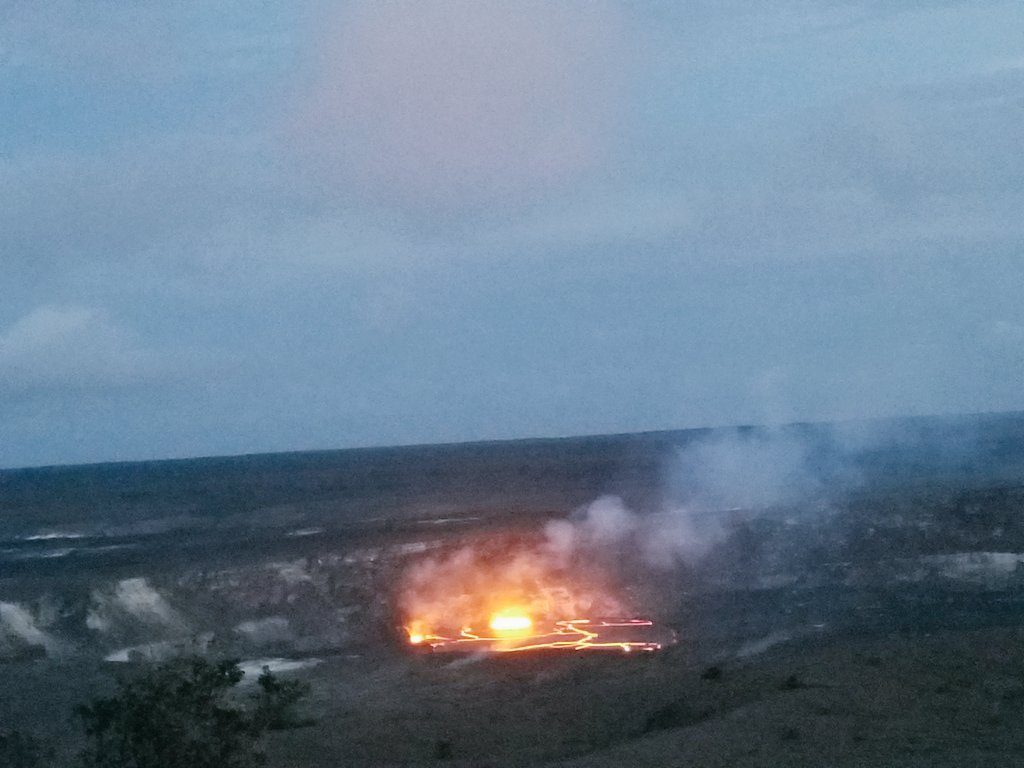
Volcanoes show-off Earth’s raw power: magma reaching the surface propels lava of different consistencies and speeds to flow across the landscape, incinerating or evaporating nearly everything it touches. Mineral and chemical deposits near their peaks dot monochromatic rocks with vivid colors. At night, the red glow of fresh lava comes to life, filling the sky with an eerie burnt umber haze. The stench of sulfur is omnipresent in different concentrations, tickling the nose with foul fumes. Some volcanic eruptions also rumble and roar to life, shaking the ground with deep bass tones or piercing the ear with high-pitched jet engine-like screeches as steam and gas escape the Earth. Confined primarily to the Ring of Fire around the Pacific, they aren’t a common scene to many. With such a geological and seismic treat, it begs the question: should volcanoes attract visitors?
We shot this boiling cauldron of mud inside #WhiteIsland / #Whakaari volcano. One of many interesting sites inside the increasingly dangerous #volcano. pic.twitter.com/uYykdaTSjF
— the Weatherboy (@theWeatherboy) June 27, 2019
On December 9, tragedy struck on New Zealand’s White Island. Also known as Whakaari Island, it suddenly erupted while tourists were walking inside its crater, sending a plume of hot debris and ash up into the air and onto visiting tourists, killing many in the process. The death toll stands at 16 with an additional two bodies missing but authorities expect the number to rise as people succumb to their injuries; some hospital patients have burns covering more than 90% of their body.
White Island is an active andesite stratovolcano, located off the east coast of the North Island of New Zealand, in the Bay of Plenty. It is New Zealand’s most active cone volcano, and has been built up by continuous volcanic activity over the past 150,000 years.
At the time of the eruption, there were 47 people on the island, primarily from the Ovation of the Seas, a Royal Caribbean cruise ship that sold tour packages to the volcano. New Zealand Police National Operation Commander Deputy Commissioner John Tims told reporters of the 47 on the island at the time of the eruption, 24 were from Australia, 9 were from the United States, 5 were from New Zealand, 4 were from Germany, 2 were from the United Kingdom, 2 were from China, and 1 was from Malaysia. “I cannot break down those numbers any further until we have completed the DVI (disaster victim identification) process,” Tims said.
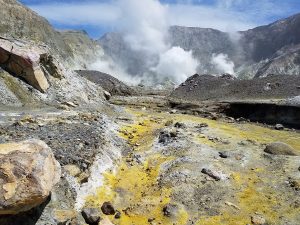
Royal Caribbean advertised a “White Island Volcano Experience Cruise and Guided Exploration” at a cost of more than $300/person. The cruise line promised “an unforgettable guided tour of New Zealand’s most active volcano ” that allows visitors to “get close to the drama: gas masks help you get near roaring steam vents, bubbling pits of mud, hot volcanic streams and the amazing lake of steaming acid.”
Royal Caribbean’s latest statement had a more conciliatory tone, saying, “The news from White Island is devastating. The details that are emerging are heartbreaking. We are working to help our guests and the authorities in the aftermath of this tragedy in any way we can. We are communicating with our guests and their families. We’re making sure they are taken care of in terms of medical help, counseling, accommodations, and transport. Our hearts go out to them, and we want to be as supportive as we can.”
Based on visuals provided from remote-controlled webcams on the island, it appears tourists had just left the area that features the main vent from the volcano and were walking back towards the coast when the eruption occurred. Within 30 seconds, ash, steam, and rock blasted the area with such force that it knocked a helicopter off its landing pad inside the crater and bent its blades, rendering it useless. The extreme heat burned the visitors, some to the point of death. Thirty-one people, aged 13 to 72, remain in the hospital this evening and 27 of those have suffered “greater than 71% body surface burns”, Ministry of Health spokesman Pete Watson said told reporters.
Last post for me on this tonight. Some expansion of images and does seem like 19-22 people in the crater 5 minutes within the time of explosion. #NewZealand #volcano #WhiteIsland #Whakaari – only time/officials will tell the final toll. pic.twitter.com/JCU8xsVeKa
— AI6YR (@ai6yrham) December 9, 2019
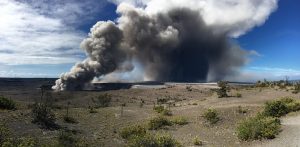
While White Island likely erupted with little sign to the tourists walking around it, scientists have been concerned about increased activity there for the last several months and especially the last few weeks. In June, geologists raised the Volcanic Alert to “level 2”, indicative of increased seismic and volcanic activity at the site which could lead to a sudden, violent eruption. And while levels of activity such as gas emissions and earthquakes have been very high since September and extremely so after recent weeks, tourists were never prevented from visiting the remote island.
Tims said an investigation will begin to study the scene to determine legal next steps. “The terms of reference will be developed over the next few days. This will be carried out in parallel with the WorkSafe New Zealand investigation.” He said WorkSafe New Zealand , which is comparable to OSHA in the United States, has opened a health and safety investigation into the harm and loss of life caused by the eruption.
But White Island isn’t the only active volcano tourists visit. In the United States, Hawaii Volcanoes National Park features two of the world’s most active volcanoes: Kilauea and Mauna Loa. While White/Whakaari Island draws 10,000 guests each year, the national park on the Big Island of Hawaii draws well over a million visitors each year; in 2017, prior to last year’s eruption event, the park saw over 2 million visitors.
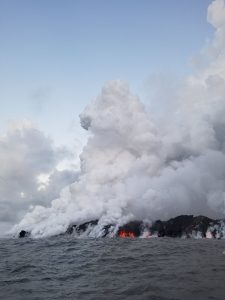
The park’s Public Affairs Specialist, Jessica Ferracane, described to us how Hawaii Volcanoes National Park takes safety seriously. “Even though our volcanoes are shield volcanoes, which are typically less violent than stratovolcanoes like Whakaari, all active volcanoes can be hazardous as the 2018 Kilauea eruption and summit collapse and previous eruptions demonstrated,” she said.
2018 was a busy year for the park’s star attraction, Kilauea. On April 30, 2018, Pu‘u ‘Ō‘ō collapsed, bringing to an end one of the most prolific active vents of Kilauea’s recent history. A few days later, a magnitude 6.9 earthquake struck, the biggest quake to hit the island since 1975. To assess damage from that May 4 earthquake, the park closed from May 4 through May 6 and reopened on May 7. On May 10, the Halema‘uma‘u lava lake drained inside Kilauea’s caldera; USGS scientists warned that explosive events at the summit could be possible in days. As a result of that warning, most of the park closed on May 11.
“During hazardous episodes, the park will close areas that present a threat to public safety”, Ferracane explains. “Last year, much of the park closed for 134 days. No one was injured or died during that eruption. While most of the park has reopened today, some areas remain closed for everyone’s safety.”
USGS Geologist Janet Babb with Hawaiian Volcano Observatory told us measurements and communication about events at the volcanoes are constant. “There are inherent dangers on any active volcano,” Babb said. “The USGS Hawaiian Volcano Observatory (HVO) closely monitors both Kilauea and Mauna Loa, Hawaii’s two most active volcanoes, and provides updates to the public through weekly and monthly updates posted on the HVO website. HVO also maintains close communication with the land managers and emergency managers who make the decisions regarding public safety, providing them with info about potential or impending volcanic hazards so that they can assess the risk and prepare themselves. Land managers can also restrict access to areas deemed too dangerous.”

One change being carefully monitored at Kilauea is the presence of a new lake in its caldera. Not seen before in modern times, both the pond’s depth and extent of the saturated zone beneath the crater have important implications concerning potential hazards at the summit of Kīlauea. If magma rises through a thin layer of water, the water would have little effect on an eruption. But with more water, the outcome depends on how quickly magma rises through and mixes with the water and in what proportions. According to USGS, one part magma to three parts water can lead to very violent explosions because there is enough thermal energy in the 2100°F magma to flash vaporize the water and fragment the magma simultaneously.
Scientists with GeoNet in New Zealand believe a water-magma interaction incident lead to last week’s fatal eruption. While an explosion could occur at Kilauea, unlike White Island, tourists aren’t walking near the middle of the crater. Babb said, “If volcanic activity interacts with the lake, it would likely have the greatest impact within the crater area — an area that is currently closed to the public. ”
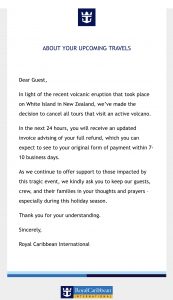
Royal Caribbean isn’t taking any chances now. Just days ago, they began informing cruise passengers that all excursions throughout the globe that visit active volcanoes will be cancelled. Melissa Charbonneau, Director of Corporate Reputation for Royal Caribbean, confirmed the policy change with us. “We can confirm that we’ve suspended all active volcano excursions across all brands. When we are able to provide further details on impact to operations, we would be happy to give you an update,” Charbonneau tells us. In addition to cruising under the Royal Caribbean International brand, the organization also owns Celebrity Cruises and Azamara Club Cruises.
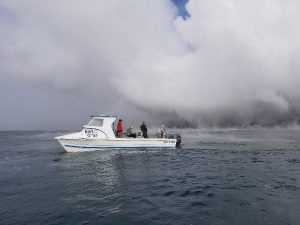
With the policy change, guests on board Celebrity’s Eclipse and Solstice, Azamara’s Journey, and Royal Caribbean’s Radiance of the Seas, Ovation of the Seas, and Serenade of the Seas will no longer be provided with the opportunity to visit Hawaii Volcanoes National Park nor will they be offered any volcano excursion that may become available should lava return to Hawaii’s Big Island.
When lava was active on the surface in 2018, tour operators did provide excursions such as “lava boats” that brought guests to the site where lava and sea water collided. Not offered nor sanctioned by the National Park, tour operators took guests to the ocean entry off the Puna Coast during last year’s eruption of Kilauea’s Lower East Rift Zone. In July 2018, a “lava bomb”, or a large blob of molten rock, exploded at the ocean entry site and landed on a nearby lava tour boat. The lava punctured through the roof of the metal boat, seriously injuring one guest and hurting 23 others on-board the boat that had a capacity to hold 49.
A tour guide died on a tour near the lava flow field in Kalapana, Hawaii in February of 2018. Sean King, a famous volcano photographer and guide, became overwhelmed by volcanic laze while escorting a tour to see the lava at night. A pop-up rain shower interacted with the lava flow, sending toxic fumes and very acidic rain towards the tour group. While the guests survived, King didn’t.
A similar deadly incident happened in November 2000. At that time, park rangers from Hawaii Volcanoes National Park discovered the bodies of a man and woman in an advanced state of decomposition. The two bodies were found about 300 feet from the site where the hot lava flow was entering the ocean. With no visible signs of trauma, the park rangers assumed they weren’t hit and killed by flying debris from the volcano, known as tephra. An autopsy report issued two days after the bodies were recovered made a startling discovery: the cause of death was pulmonary edema. Pulmonary edema, or swelling of the lungs, occurs when hydrochloric acid is inhaled. The autopsy also noted that advanced decomposition occurred where skin was exposed to the air, or covered by only a single layer of clothing. As such, the tissue didn’t decompose through natural postmortem decay; very acidic rain was the cause.
Despite these isolated accidents, the draw to the volcano doesn’t scare many away. In a National Park Service report released last spring, 2,016,702 visitors came to Hawai’i Volcanoes National Park in 2017 alone and spent $166 million in communities near the park. That spending supported 2,020 jobs in the local area, and had a cumulative benefit to the local economy of nearly a quarter-billion dollars.
As authorities in New Zealand continue to tackle the fresh White Island disaster there and travel companies such as Royal Caribbean develop policies to protect their passengers moving forward, it remains to be seen if peoples’ appetite to visit such natural tourist attractions will persist even in light of these tragedies.